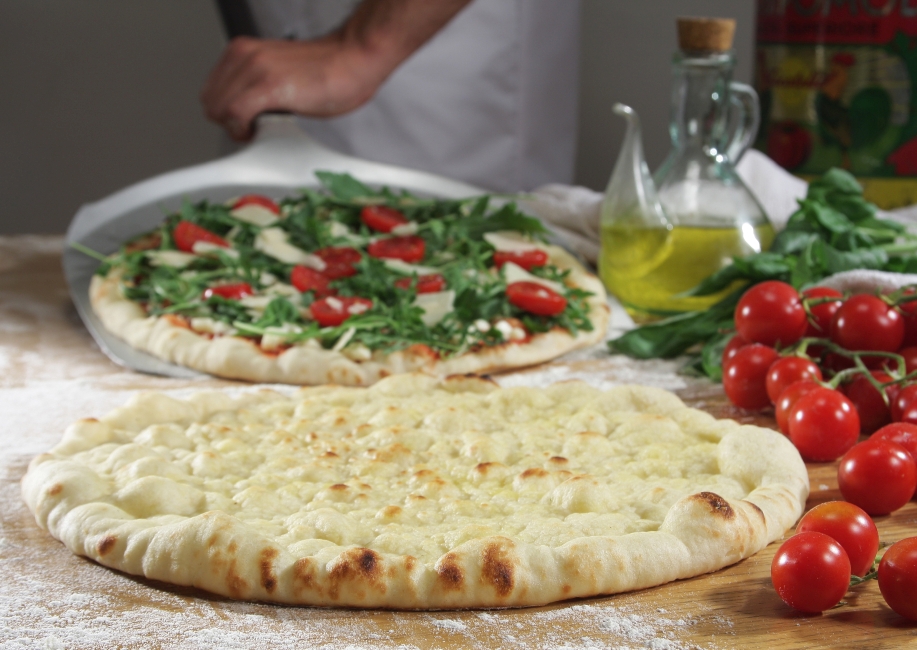How to make Great Pizza for Your Restaurant or Foodservice Operation
Deciding whether to make pizza using dough, a par baked crust or a frozen dough ball
Making dough is an art, brought to the US from Italy. The crust is the foundation for all pizza, and the ability to make dough from scratch and create an outstanding pizza, is the cornerstone of any pizzeria.
Yet, pizza has evolved from the Italian specialty, to a ubiquitous as well as diverse category of food, not just limited to the local pizza place, but integral to everything from bars, pubs and bistros, to high end restaurant flatbread iterations and so much more.

Par baked pizza crusts evolved out of a growing demand for pizza in more places, create more ways, by a vast diversity of operation types. Unfortunately, it became commonplace for quality and authenticity to be secondary to price and speed. This was the basis for the introduction of ItalCrust.
What’s the best way to make pizza for your operation depends on your labor, cost and quality goals and while using a par baked crust is the option that we can help you with, there are always considerations for making your own dough as well:
– Making dough from scratch is a labor intensive, and artisan process. Learning how can be very rewarding and the ingredient cost itself is quite low, even when using the best flour. If your restaurant has a regular, consistent, knowledgeable pizza maker, then you may want to consider making dough from scratch.
– Buying frozen dough balls is another option. This will give you more control over the finished product, as well as the ability to need less storage space. As long as you have a pizza oven or, even better, a wood fired oven, this is a great option for you.
– Pre and par baked crusts used to be the last resort, a decision to abandon quality and just make “commodity” pizza. But ItalCrust started to change that, and while few can offer a truly authentic premade crust in our price range, there are local pizzerias who will sell you a par baked crusts, if you can afford it.
How to make pizza for your restaurant or foodservice operation is a decision that you have to consider carefully, weighing the cost of labor, time and space against the cost of ingredients, and the final cost of the product. In our experience, most delivery pizza is carefully shopped, but most pizza entrees have some flexibility when coming from other types of restaurants. And a well known local pizza shop, will always have a following – if the pizza is really good. Anyone can be cheap. Not everyone can be great.
Naan Bread Pizza?
Naan is an Indian bread, made with 15-30 different ingredients. The Americanized version of Naan, occasionally used for pizza can contain dairy, egg and/or soy. While Naan bread is flavorful, it should never be used to make pizza for the simple reason that Naan bread will burn to quickly, preventing your cheese and toppings from being able to properly cook. For the at home cook, Naan bread may make perfect sense, but for a restaurant the use of Naan bread to make pizza may not be the wisest choice, unless of course the goal is to make an Indian cuisine pizza.
how to choose the Best toppings for pizza and flatbreads
topping pizza is really two different sets of decisions
The base of your pizza will include the crust, the sauce and the cheese. Many pizza operations can have more than one base, such as a tomato base, a pesto base and a white pizza, alfredo or bechamel base. Whether you have one base, which is to say, one set receipe for crust, sauce and cheese, this will be the foundation of your pizza which will likely not change from month to month. The base is what will truly distinguish one pizza from the other, and will determine the difference between good pizza and great pizza.
The second category, the toppings typically listed on the menu such as pepperoni, mushrooms, grilled chicken or vegetables, are often over thought. There are unquestionably fantastic toppings for pizza, both in quality and in the mix of recipe, but the reality is that a great base will elevate any topping. Your toppings can change from day to day or week to week, and each recipe will appeal to different people. Don’t get us wrong: Great recipes and quality toppings can truly distinguish a great pizza and a great pizza operation, but the foundational quality of your pizza comes from the crust, the sauce and the cheese. And if your cheese pizza is great, then everything you create from there will also great.
The hardest part of making pizza is making the dough, but it is also the key to great pizza and the cornerstone of the type and quality of your pizza. Even the finest toppings will not make up for a poor crust, while an outstanding crust will truly elevate whatever toppings you add.
Best oven for Making Pizza
Pizza oven choices
When baking true pizza, from pizza dough or a premium quality pre made crust such as ItalCrust, there are many oven choices that will all cook your pizza well. The key to making great pizza is going to be high heat. Pizza is not meant to be slow cooked, but if you use an inferior par baked crust, pita, or naan bread, you risk burning it in a hot oven.
The advantage to ItalCrust or to having a wood fired oven is that an additional flavor element is added, the aroma of the wood. Pretty much all other ovens will vary the surface, the heat intensity, and the circulation of air but they won’t directly impact the flavor. One of the misconceptions out there is that brick ovens will somehow change your pizza, and this is simply not true. The advantage to brick is that is has the potential to reach very high temperatures, but what you burn to create the heat will determine the flavor.
The majority of restaurants use convection or conveyor (also known as impingers) ovens, or a newer concept called a “Combi” oven which combines convection and microwave. Some of these newer ovens are quite extraordinary, cooking a pizza in under two minutes and doing so quite well.
Other considerations are the surface, that is whether the pizza is baked on a stone. Many ovens already have a deck, which acts like a stone. The advantage to the stone or deck is that it can get incredibly hot and will directly touch the dough. This will create a crisp bottom, and will help to quickly create bottom heat that will raise the temperature of the sauce which then cooks the toppings above it.
But convection ovens have the advantage of being widely available, and easy to manage. Most pizza baked in convection needs little attention, whereas some fancier pizza ovens can sometimes require close monitoring, and positioning of the pizza.
If you decide to use ItalCrust, you benefit from having a product that is cooked in a real wood fired oven (we used oak and beech), on stones, and at very high heat (~850 degrees). This allows you to finish your bake in virtually any oven type because the advantages of the wood, the high heat and the stone are already baked in.
.

